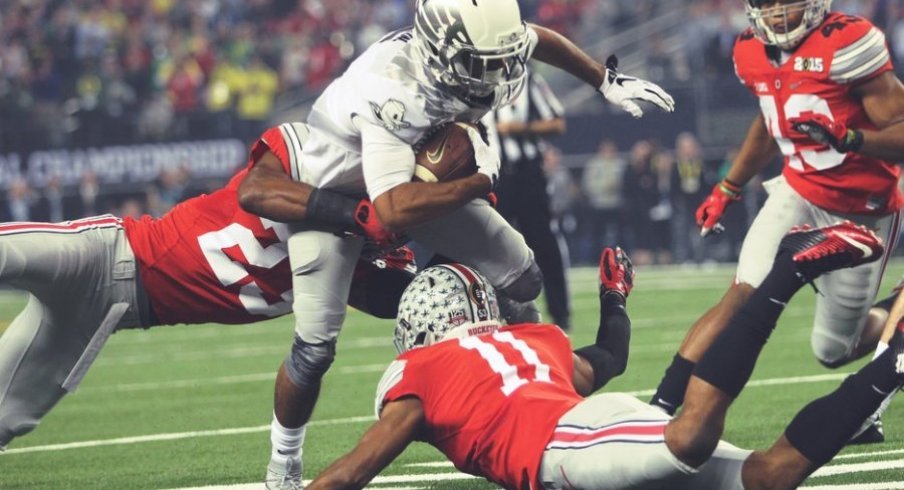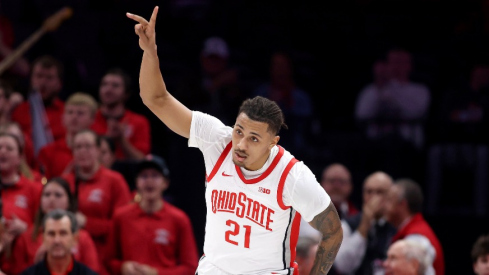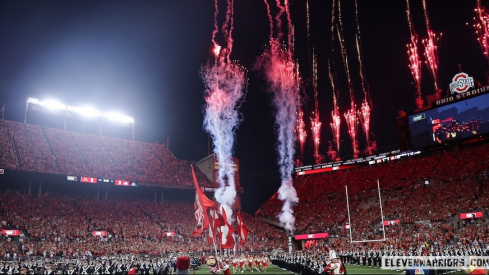Late-night YouTube sessions, persistence from a new coach, and the sport of rugby have transformed the Buckeye defense into one of the top-tackling units in the country.
Entering the 2014 season, the vaunted Silver Bullet defense had become a shell of its former self. Years of soft coverage and missed tackles had turned an aggressive in-your-face unit into a reactionary defense in which missed open field tackles had become the norm.
Season-ending losses to Michigan State and Clemson in 2013 in which Buckeye defenders whiffed in the open field time after time amplified the lack of tackling ability and passive nature of the unit. With this lack of identity in mind, newly hired Buckeye co-defensive coordinator, and current Rutgers head coach, Chris Ash stumbled upon a video during a late-night YouTube film session that radically transformed the Buckeye defense’s philosophy on taking the ball carrier to the ground.
 (Image courtesy of football-tutorials.com)
(Image courtesy of football-tutorials.com)
For decades most coaches have taught traditional forms of tackling in which the defender brings his head across and into the ball carrier’s body, or puts his facemask on the ball. While players are coached to keep their head up as they strike the target (“see what you hit”), these techniques often lead to head injuries and missed tackles as defenders drop their head at the point of contact. As you can see from the drill above, the tackler's head clearly aims for the chest plate, and any drop in helmet level will result in the defensive player spearing with the crown.
With the current climate placing a heavy emphasis on player safety, coaches at all levels of football are looking for ways to take the head out of tackling completely. Enter current Seattle Seahawks head coach Pete Carroll and the tackling techniques he has taught since his days as USC’s head coach.
Known in Carroll’s verbiage as ‘shoulder-leverage tackling', the Seahawks' philosophy of taking the defender’s head out of the tackle and altering the strike point came from an almost 200-year-old sport: rugby football.
In his ground-breaking video first released to thousands of high school coaches through the film site Hudl, Carroll explained, “Our tackling system has been inspired by those who play rugby around the world. Rugby players have done a tremendous job at taking the head out of the tackle in their game, and they truly exemplify shoulder tackling.”
As rugby players compete with no pads or helmets, the techniques taught and used in the sport harken back to the days of backyard football, when wrapping up was the surest way of making a tackle and avoiding injury.
Carroll’s video immediately struck a chord with Ash, who later said, “I probably watched that video that Pete Carroll put out like, 20 times, to be honest with you. Because I wanted to just keep going back, listening to what he was talking about — ‘safety was the number-one thing, safety, safety, safety,' and I thought, you know what? I don't know that the way we're teaching tackling is necessarily unsafe, but should we change? So, I thought, I'm not going to put this to bed. I'm going to go watch our film."
After going back and reviewing game film the new co-defensive coordinator noticed unsafe technique popping up on the film over and over, saying "I start watching our film and I'll be damned. Everything he's talking about (in regards to unsafe technique) is showing up on film, and we're not even coaching it.”
Ash pulled together the defensive coaching staff and continued to analyze film and tackling techniques that were being taught in practice. After concluding that rugby-style tackling would lead to improved player safety and fewer missed tackles Ash brought the idea to head coach Urban Meyer, who initially balked. Meyer said the philosophical change “Was one that I fought at first and I said no, we're not going to do that”.
With the urging of the defensive coaching staff Meyer conducted his own research and analysis, saying “I did as much research as I could and ultimately we jumped in. Tremendous success right out of the get-go. You could see the difference.”
The three-time national champion head coach later concluded that rugby-style tackling played a huge role in the Buckeye’s 2014 national championship, saying “We had the fewest missed tackles in the country.”
A core tenet of the philosophy is leverage-based tackling, or approaching the ball carrier at the correct angle to limit missed tackles, a concept coined by the Seahawks' head coach as ‘compression tackling’. While most spill-based defenses utilize the philosophy, Carroll’s video is noteworthy for its clear articulation of the concept, coaching points, and inclusion of drills used to reinforce the compression tackle.
Pete Carroll defines the compression tackle as simultaneous tackles that occur between two or more defenders. If executed correctly, the offensive player will be left with nowhere to go as the would-be-tacklers have cut off the outside AND inside parts of the field. The only place to go is straight though them. Compression tackles can occur between players from any position group on the field. Examples pulled from Carroll's video show defenders from all three levels making tackles as a duo.
A cornerback and linebacker:

A safety and linebacker:

A defensive tackle and defensive end:

Compression tackling technique can be broken down into three parts:
- Own your hip
- Squeeze the ball carrier
- Break down in space
Own Your Hip
The coaching point ‘Own your hip’ is the most important part of making a compression tackle. The idea is relatively simple: Any player attacking the ball carrier from the outside will aim for the outside (near) hip of the ball carrier, while any players attacking from the inside will aim for the inside (near) hip of the ball carrier.
A good rule of thumb to remember is if the defender has outside leverage (position) on the ball, the ball carrier CANNOT get OUTSIDE his body. If the defender has inside leverage on the ball, the ball CANNOT get INSIDE his body. Go back to the clips above and focus on how the defenders attack the ball carrier. Notice how the outside defender strikes the outside hip of the ball carrier while the inside defender strikes the inside hip.

It is vital for defenders to focus solely on the ball carrier’s hip. College skill players are fast, strong, and shifty. If the defensive player focuses on the shoulders and head rather than the hip, the opponent can easily get outside or inside (known as losing leverage) the tacklers. The hips don’t lie; defenders should ALWAYS focus on the hips as they track the ball and close in to make a tackle.
Squeeze the Ball Carrier
As both defenders approach the ball carrier, they will squeeze together towards their respective aiming points (the outside and inside hip) to reduce the distance between both so the ball carrier cannot turn the ball upfield between the two. They must not squeeze too tightly too soon, or the ball carrier will have an opportunity to escape outside/inside. Again, own your hip and give the offensive player a one-way go; right through the tackle.


Break Down in Space
When closing on the ball, defenders will ‘get athletic’ in preparation for the tackle. The body should be in position to strike, with the inside foot up. In the Seahawks' system, tacklers will generally strike the ball carrier in the thigh area with the inside shoulder and chest. The head should stay on the outside and the arms should wrap. They are taught to ‘wrap and squeeze’ and ‘drive for 5’ by wrapping the leg at contact and moving the feet to drive the ball carrier backwards.

It’s also important for the defenders not to lunge toward the ball carrier in the open field. Eyes on the hips, keep moving your feet, and close on the ball. While the offensive player is trying to shake you, the other defender is closing in on him from the other side. Let him dance.
Seattle's team tackling video includes several clips of the team running the compression drill as part of their tackling circuit. One of the strengths of the rugby-style tackling system is the ability to rep the skills and techniques without making contact or going to ground. This always the defensive coaching staff to rep compression tackling as part of a tackling curcuit every practice without fear of contact-based injuries.
Focus on how defenders stick to their aiming points and own their leverage regardless of the angle they take to the ball. Also pay attention to the defender’s bodies when they ball carrier starts dancing, as they get athletic and move the feet to keep the ball from breaking outside/inside, avoiding a loss of leverage.
Finally, focus on how the defenders adjust their path to the ball carrier when the ball isn’t thrown directly down the middle. You’ll see the play side defender (the player the ball is closest to) angle his path to force the ball back towards his partner while owning his hip.

The Silver Bullets were back in full force during Ohio State's 42-20 national championship victory over an Oregon team that averaged 547 yards and 45.4 point per game. Outside the first two drives, the unit bottled up the potent Oregon runing game while delivering solid hits on Oregon's ball carriers play-after-play, in a game that wasn't as close as the score indicated.



Facing all-world wide receiver Will Fuller to close out the 2015 season in the Fiesta Bowl, the Ohio State defense went into practice with Sammy Watkins' 227-yard, two touchdown Orange Bowl performance in mind.
While the talented junior wide receiver did record an 81-yard touchdown catch, he was stymied on the screen plays Sammy Watkins repeatedly scorched the Buckeye defense with on the way to a record-setting effort in the 2014 Orange Bowl.

Expect little to change with the addition of new co-defensive coordinator Greg Schiano. The seasoned defensive coach's philosophy aligns well with the core tenets of rugby tackling, and he likely would not have been added to the coaching staff without a full commitment to the wildly successful ideology. Thanks to the late-night habits and persistence of recently departed coach Chris Ash, it's safe to say the Silver Bullets have their shine back.


